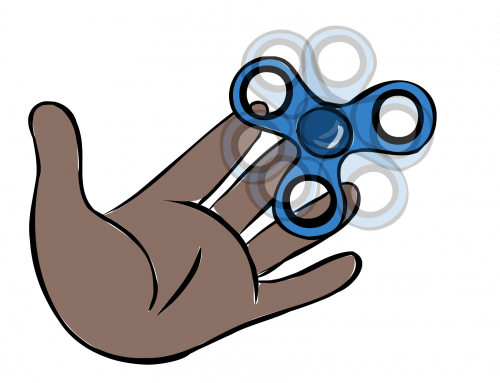A ballerina, who took physics in school and realized she really likes physics, realized that contracting her arms while twirling reduces her moment of inertia to that of \({one quarter}\) the moment of inertia while twirling with her arms outstretched.
a) If she spins at 22 rpm with her arms outstretched, calculate her angular speed when she contracts her arms.
b) For a dance move, she must hug another dancer with the same moment of inertia so that the two of them spin together at 30 rpm. What angular speed should she have before the maneuver? (Assume the other dancer is at rest before the interaction.)
a) Apply Conservation of Angular Momentum to find the angular velocity.
b) Same hint as part (a).
a) Conservation of Angular Momentum gives:
\begin{equation*}
\vec{L}_i = \vec{L}_f,
\end{equation*}
[mepr-show rules=”4409″ unauth=”both”] where the angular momentum \( \vec{L} = I \vec{\omega}\). Since \(I_f = I_i / 4\) as stated in the problem, we get:
\begin{equation*}
\omega_f = 4 \omega_i,
\end{equation*}
which, with numerical values, yields:
\begin{equation*}
\omega_f = 88 \, \text{rpm}.
\end{equation*}
b) Conservation of Angular Momentum in this case gives:
\begin{equation*}
I \omega_i = 2 I \omega_f,
\end{equation*}
where solving for \(omega_i\) we get:
\begin{equation*}
\omega_i = 60 \, \text{rpm}.
\end{equation*}
For a more detailed explanation of any of these steps, click on “Detailed Solution”.
[/mepr-show]
(a) The first part of the problem asks us to calculate the angular speed of the dancer. To approach this problem, we must use the conservation of angular momentum \(\vec{L}\). We’re able to use this conservation theorem because when the dancer contracts her arms, no external torque \(\vec{\tau}\) is applied to her body; thus, the sum of all torques is equal to zero, namely
\begin{equation}
\sum \vec{\tau}=\vec{0}.
\end{equation}
[mepr-show rules=”4409″ unauth=”both”]
We may now apply the conservation theorem as follows
\begin{equation}
\label{cons}
\vec{L}_i=\vec{L}_f,
\end{equation}
where \(\vec{L}_i\) and \(\vec{L}_f\) are the initial and final angular momentum, that is before and after the dancer contracts her arms.
The angular momentum for a rigid body with moment of inertia \(I\) and angular velocity \(\vec{\omega}\) can be calculated as
\begin{equation}
\label{angularm}
\vec{L}=I\vec{\omega}.
\end{equation}
Using the definition given in equation \eqref{angularm} into equation \eqref{cons}, we obtain
\begin{equation}
\label{cons2}
I_i\vec{\omega}_i=I_f\vec{\omega}_f,
\end{equation}
where \(I_i\) and \(\vec{\omega}_i\) are the moment of inertia and angular velocity before the dancer contracts her arms and \(I_f\) and \(\vec{\omega}_f\) are the moment of inertia and angular velocity after the dancer contracts her arms.
The problem tells us that the dancer’s moment of inertia is reduced to a quarter when the she contracts her arms. Then,
\begin{equation}
I_f=\frac{I_i}{4}.
\end{equation}
Using the relation given above in equation \eqref{cons2}, we get
\begin{equation}
I_i\vec{\omega}_i=\frac{I_i}{4}\vec{\omega}_f,
\end{equation}
where we can cancel out the term \(I_i\) to get
\begin{equation}
\vec{\omega}_i=\frac{1}{4}\vec{\omega}_f.
\end{equation}
Solving for \(\vec{\omega}\) in the equation above, we get
\begin{equation}
\label{cons3}
\vec{\omega}_f=4\vec{\omega}_i.
\end{equation}
Thus, both angular velocity vectors are parallel. Focusing on their magnitudes in equation \eqref{cons3}, we obtain the relation for the angular speed
\begin{equation}
\omega_f=4\omega_i.
\end{equation}
Using the numerical values given in the problem, we get
\begin{equation}
\omega_f=4(22\,\text{rpm}),
\end{equation}
\begin{equation}
\omega_f=88\,\text{rpm}.
\end{equation}
(b) To solve for the initial angular speed of the dancer we must use the conservation of angular momentum as written explicitly in equation \eqref{cons2}. This time, the initial point is just before the dancers perform the maneuver, and the final point is right after they execute the maneuver.
The initial angular momentum is due to the one dancer that is rotating before the interaction with speed \(\vec{\omega}_i\). For the final point, the angular momentum of the system is composed by both dancers rotating with angular velocity \(\vec{\omega}_f\) . Explicitly, using equation \eqref{cons2} we get
\begin{equation}
I\vec{\omega}_i=2I\vec{\omega}_f,
\end{equation}
where we used the fact that the dancers have the same moment of inertia \(I\). After simplification this becomes
\begin{equation}
\label{omegas}
\vec{\omega}_i=2\vec{\omega}_f.
\end{equation}
Focusing on the magnitude of the angular velocities, we have the following relation
\begin{equation}
\omega_i=2\omega_f.
\end{equation}
Using the numerical values, we get
\begin{equation}
\omega_i=2(30 \, \text{rpm}),
\end{equation}
\begin{equation}
\omega_i=60\,\text{rpm}.
\end{equation}
[/mepr-show]
You need to be registered and logged in to take this quiz. Log in




Leave A Comment